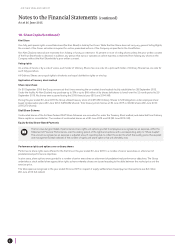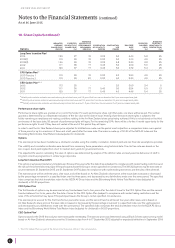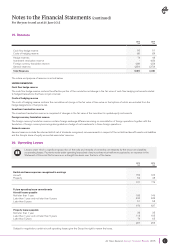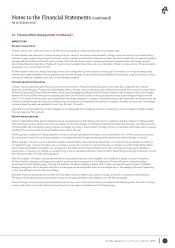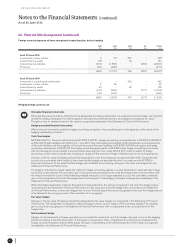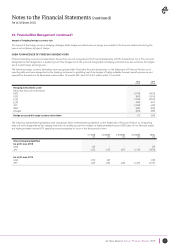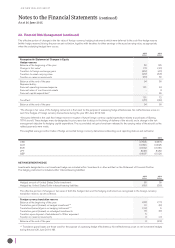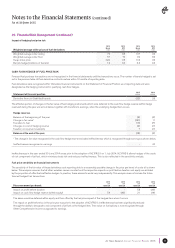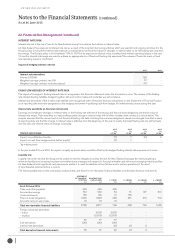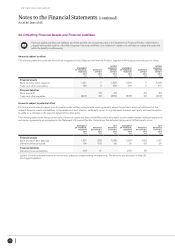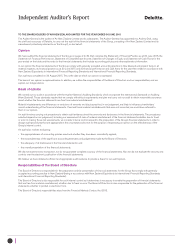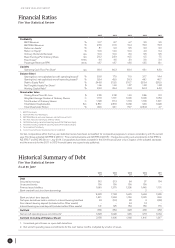Air New Zealand 2015 Annual Report Download - page 36
Download and view the complete annual report
Please find page 36 of the 2015 Air New Zealand annual report below. You can navigate through the pages in the report by either clicking on the pages listed below, or by using the keyword search tool below to find specific information within the annual report.
AIR NEW ZEALAND GROUP
Notes to the Financial Statements (continued)
As at 30 June 2015
34
23. Financial Risk Management (continued)
Foreign currency sensitivity on financial instruments
The following table demonstrates the sensitivity of financial instruments at reporting date to a reasonably possible appreciation/depreciation in the
United States Dollar against the New Zealand Dollar. Other currencies are evaluated by converting first to United States Dollars and then applying
the above change against the New Zealand Dollar. All other variables are held constant. This analysis does not include future forecast hedged
operating or capital transactions.
Appreciation/depreciation (US cents):
2015
NZ$M
+5c
2015
NZ$M
-5c
2014
NZ$M
+5c
2014
NZ$M
-5c
Impact on profit before taxation
USD 69 (80) 15 (16)
The above would be offset in earnings through either the fair value hedge mechanism or through the impact of foreign currency on depreciation.
Impact on equity
USD
AUD
EUR
JPY
GBP
OTHER
(59)
(13)
3
29
6
5
68
15
(4)
(34)
(7)
(6)
(53)
(9)
4
14
6
4
59
10
(4)
(16)
(6)
(5)
The above would be deferred within equity and then offset by the foreign currency impact of the hedged item when it occurs.
2015 2014
Significant foreign exchange rates used at balance date for one New Zealand Dollar are:
USD
AUD
EUR
JPY
GBP
0.6850
0.8920
0.6100
83.90
0.4350
0.8775
0.9315
0.6430
89.00
0. 5150
FUEL PRICE RISK
Fuel price risk is the risk of loss to Air New Zealand arising from adverse fluctuations in fuel prices.
NZ IFRS 9 permits hedge accounting of risk components of both non-financial and financial items, provided they are separately
identifiable and reliably measurable. Crude oil derivatives, which were previously designated as a proxy for jet fuel derivatives, are
now designated in qualifying cash flow hedges of the crude oil component of highly probable future jet fuel purchases. This change
has been applied prospectively with effect from 1 July 2014 and better aligns the accounting of such derivatives with the Group’s
risk management strategy, resulting in a more logical outcome. Accounting ineffectiveness may still arise where the price index of
the designated hedging instrument is different to the crude oil benchmark in the geographical location of the hedged fuel uplift.
The price risk of jet fuel purchases includes a crude oil price risk component, despite crude oil not being specified in any
contractual arrangement. Based on an evaluation of the market structure and refining process, this risk component is separately
identifiable and reliably measurable even though it is not contractually specified. The relationship of the crude oil component to jet
fuel as a whole varies in line with the published crude oil and jet fuel price indicies. Crude oil hedging instruments are designated
as a hedge of the price risk in the crude oil component of highly probable jet fuel purchases. There is a 1:1 hedging ratio of the
hedging instrument to the crude oil component identified as the hedged item.
Ineffectiveness is only expected to arise where the index of the hedging instrument differs to that of the underlying hedged item.
Air New Zealand enters into fuel swap and option agreements to reduce the impact of price changes on fuel costs in accordance with the policy
approved by the Board of Directors. Uplift in the first three months is hedged between 50% and 80% with the volume falling to 20% in the
twelfth month.
Some components of hedge accounted derivatives are excluded from the designated risk. Cash flow hedges in respect of fuel
derivatives include only the intrinsic value of fuel options. Time value on fuel options is excluded from the hedge designation
and, with the adoption of NZ IFRS 9, is now marked to market through Other Comprehensive Income, and accumulated within
a separate component of equity (the ‘Costs of Hedging Reserve’ within ‘Hedge Reserves’), until such time as the related hedge
accounted cash flows affect profit or loss. At this stage the cumulative amount is reclassified to profit or loss within ‘Fuel’.


